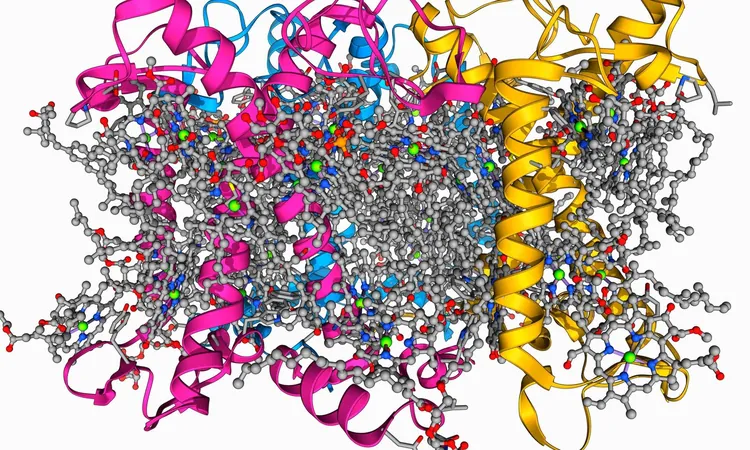
Breakthrough Discovery Unveils Ribosome Teamwork That Fuels Protein Synthesis
2025-05-24
Author: William
Ribosomes: The Unsung Heroes of Cell Function
In the intricate world of cellular biology, ribosomes serve as the essential machines that transform genetic codes into proteins—crucial players in everything from metabolism to growth. For years, scientists held the belief that ribosomes would simply stall and vanish when they hit an obstacle on an RNA template.
A Game-Changing Perspective
Thanks to groundbreaking research by Dr. Marvin Tanenbaum's team at the Hubrecht Institute, this outdated notion is being overturned. Their findings indicate that ribosomes might actually exhibit remarkable resourcefulness when encountering roadblocks.
The Surprising Dance of Ribosomal Collaboration
Using advanced microscopy to observe ribosomes in real-time within living cells, the researchers stumbled upon a fascinating dynamic: instead of halting for quality control, ribosomes continued their work despite colliding with one another.
Dr. Maximilian Madern noted, "We found that brief collisions do not prompt immediate intervention from the cell’s quality control mechanisms." This means that when collisions are fleeting, the usual response systems remain inactive.
Different Speeds, One Goal
Lead author Sora Yang revealed that ribosomes move at different paces, often pausing for varying durations. This revelation challenges the long-held belief that ribosomes progress uniformly through the RNA sequence.
When a faster ribosome catches up to a slower one, brief collisions occur, yet the lagging ribosome frequently resumes its task without needing to be discarded.
The Role of Timing in Ribosomal Function
However, if a ribosome remains stalled for an extended period, quality control steps in to dismantle the troublesome complex. This highlights the importance of timing in ribosomal activity, with quick collisions passing unnoticed while prolonged stalling triggers significant interventions.
Illustrating Ribosome Cooperativity
One of the most intriguing findings is the concept of 'ribosome cooperativity.' When two ribosomes work together, they can navigate tricky segments of RNA more effectively. This cooperation deviates from the understanding that crowded ribosomes merely hinder progress; rather, in certain situations, they can actually accelerate protein synthesis.
Implications for Cellular Efficiency and Health
This newfound cooperation could enhance cellular efficiency, helping to prevent minor hiccups from escalating into major production issues. Moreover, understanding ribosomal teamwork could provide insights into various diseases linked to dysfunctional ribosome activity, opening potential avenues for innovative therapies.
Advancing Research and Future Discoveries
With the advent of new imaging techniques, scientists are optimistic about observing the nuances of ribosomal behavior during protein synthesis. Every breakthrough prompts a re-evaluation of genetic expression, revealing how small shifts can impact larger biological systems.
As research continues, the concept of ribosomes as identical, unchanging machines is becoming obsolete. Instead, they reveal unique patterns of movement and demonstrate a remarkable ability to collaborate.
Looking Ahead: The Future of Ribosome Research
The implications of these findings extend beyond fundamental biology, potentially influencing fields like synthetic biology and industrial applications. Enhanced understanding of ribosome dynamics might lead to improved methods for producing essential proteins, from enzymes to vaccines.
As studies delve deeper into the complexities of ribosomal behavior, it could also unveil novel connections to gene regulation, enriching our comprehension of how cells guide protein synthesis during challenges.
Rethinking Genetic Expression and Disease
The revelations surrounding ribosome collisions challenge the previous view that such events were merely nuisances. Instead, they present a new understanding that momentary encounters can facilitate, rather than hinder, the protein synthesis process. As we continue to refine our research methods, the path ahead promises to reshape our understanding of gene expression and its implications for health and disease.
This groundbreaking study was published in the esteemed journal Cell.









 Brasil (PT)
Brasil (PT)
 Canada (EN)
Canada (EN)
 Chile (ES)
Chile (ES)
 Česko (CS)
Česko (CS)
 대한민국 (KO)
대한민국 (KO)
 España (ES)
España (ES)
 France (FR)
France (FR)
 Hong Kong (EN)
Hong Kong (EN)
 Italia (IT)
Italia (IT)
 日本 (JA)
日本 (JA)
 Magyarország (HU)
Magyarország (HU)
 Norge (NO)
Norge (NO)
 Polska (PL)
Polska (PL)
 Schweiz (DE)
Schweiz (DE)
 Singapore (EN)
Singapore (EN)
 Sverige (SV)
Sverige (SV)
 Suomi (FI)
Suomi (FI)
 Türkiye (TR)
Türkiye (TR)
 الإمارات العربية المتحدة (AR)
الإمارات العربية المتحدة (AR)